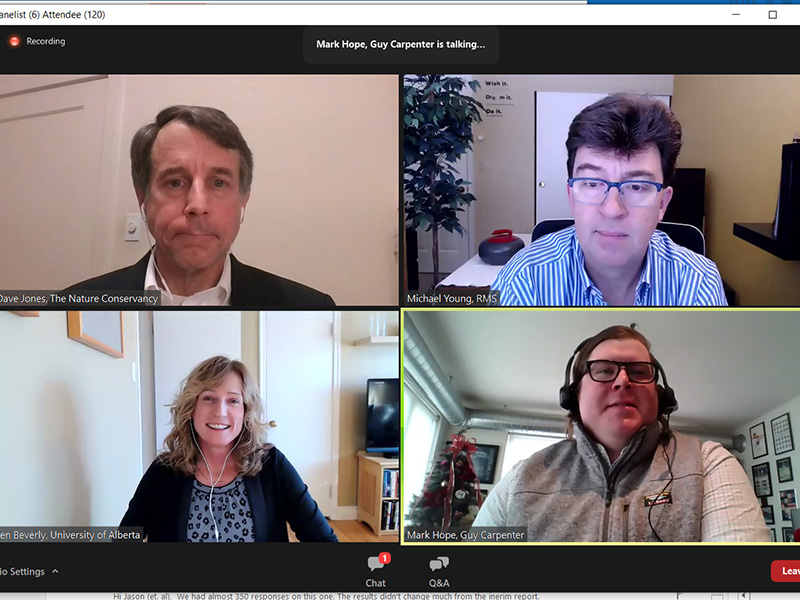
Wildfire damage is not like a Godzilla attack. Why that matters to Cat modellers
December 7, 2020 by Greg Meckbach

Print this page Share
A client’s structure can remain standing after a wildfire, even when other buildings in the same neighbourhood burn down, because dozens of factors affect a property’s risk, experts said Thursday during a webinar.
“The interesting thing about wildfire is [that] it is a little bit different from earthquakes and hurricanes and convective storms,” said Michael Young, vice president of product management at catastrophe modelling firm Risk Management Solutions (RMS) Inc.
On the one hand, earthquakes and hurricanes tend to affect large areas.
“But wildfires are actually a type of phenomenon that is hyper-local,” Young said Thursday during Wildfire Science & Management: Modelling Update, a virtual panel hosted by Catastrophe Indices and Quantification Inc. (CatIQ).
This means a wildfire catastrophe model needs to have a “fine resolution,” or capable of predicting insured losses within a small area on the order of 50 metres square.
“To do that on a nation-wide basis requires big-data elements,” Young said during the panel, part of New in Catastrophe Technology & Modelling, a one-day webinar.
RMS has introduced its North America wildfire model for insurers, which RMS says has 50 metres of resolution.
To illustrate the complexity in creating wildfire models for insurers, Young said he likes to quote data from property damage within areas severely affected by a wildfire.
“Most people intuitively think, ‘Godzilla came in and stomped on top of everything in that footprint,’ but there is actually a survivability associated with that.” By that, Young means it often turns out that 30% to 60% of the structures inside a wildfire footprint survive.
Young gave several examples of factors affecting wildfire risk – including roof cover materials, whether or not roof vents are protected and whether or not the owner has removed all burnable vegetation within five feet of the building.
Meanwhile, Canada’s Institute for Catastrophic Loss Reduction warns that if a roof is made of untreated wood shakes, this can be particularly hazardous in a wildfire, compared to materials like metal, asphalt, clay or composite rubber tiles. Risk mitigation measures recommended by ICLR include cleaning debris out of roof gutters and not storing firewood or propane tanks within 100 metres of the home.
Canada ranked third behind the United States and Indonesia in a Lloyd’s report listing the countries with the greatest amount of economic damage from wildfire between 1990 and 2012.
In 2016, a wildfire forced the evacuation of the entire city of Fort McMurray, Alta. With insured losses of nearly $4 billion, the 2016 blaze set a new Canadian record for industry-wide insured losses from a natural catastrophe. Another wildfire is also on the Top 10 list of costliest Canadian natural catastrophes. In 2011, the Slave Lake, Alta. wildfire cost the industry $591 million, A.M. Best Company Inc. reported earlier.
During the CatIQ webinar Dec. 3, panelists were asked why the 2020 Canadian wildfire season has been relatively benign.
“It rained,” replied Jen Beverly, an assistant professor at the University of Alberta, whose areas of expertise include fire risk assessment and wildfire evacuations.
Beverly has not seen any formal studies on weather conditions over the past year but she reported it has been rainy in Western Canada this year.
“Some people have suggested [the relatively benign 2020 Canadian wildfire season] may have something to do with people not being out in the forest as much due to COVID and other factors,” Beverly reported, referring to the emergency measures in place throughout much of 2020 due to the novel coronavirus pandemic.
The human factor is important in assessing wildfire risk, added Young.
“It is not just a purely natural phenomenon. Most people think of it as [things like] lightning strikes out in the middle of the forest. And that is the main driver, but what we have actually found by looking at statistics in both Canada and the U.S. is the large majority of wildfires actually have a human ignition relationship,” such as camp fire accidents and industrial accidents, said Young.
New in Catastrophe Technology & Modelling was one of the CatIQ Connect series of quarterly talks. The next quarterly talk is scheduled Feb 11.
Have your say: